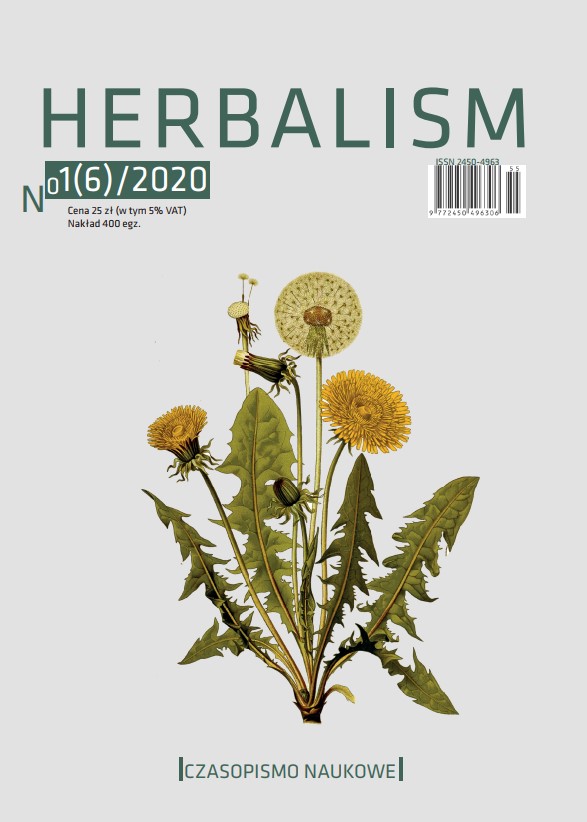Naturalne czy syntetyczne? Fitoterapia i fitochemia jako inspiracja dla syntezy organicznej związków naturalnych
DOI:
https://doi.org/10.12775/HERB.2020.001Słowa kluczowe
fitochemia, bioaktywne związki, mentol, salicyna, hiperycyna, 1-DNJAbstrakt
Większość leków syntetycznych, którymi dysponuje współczesna medycyna powstała w oparciu o substancje obecne w lekach roślinnych. Naturalne źródła roślin leczniczych są na wyczerpaniu, a zmiany klimatyczne mają wpływ na uprawy ziół na plantacjach. Jednocześnie rośnie popyt na bioaktywne związki i ekstrakty z roślin. Racjonalna toterapia potrzebuje preparatów o zidentykowanym składzie, znanym farmakologicznym działaniu składników i skuteczności potwierdzonej w badaniach klinicznych. Do wykonania badań in vivo na zwierzętach i badań klinicznych potrzebne są w większych ilościach poszczególne składniki. Przedmiotem zainteresowania są takie związki jak mentol, składnik olejku miętowego, salicyna z kory wierzby czy1-deoksynojirimycyna z białej morwy. Można je otrzymać przez izolację z roślin, ale
konieczne jest opracowanie metod ich totalnej syntezy chemicznej. To inspirujące zadanie dla chemików i pierwszy etap w produkcji przemysłowej.
Bibliografia
Krzyżanowska J., Janda B., Pecio Ł., Stochmal A., Determination of polyphenols in Mentha longifolia and M. piperita eld-grown and in vitro plant samples using UPL-C-TQ-MS, Journal of AOAC International, 2011, 94(1), s. 43–50.
Khanna R., Khanna R., MacDonald J.K., Levesque B.G., Peppermint oil for the treatment of irritable bowel syndrome: a systematic review and meta-analysis, Journal of Clinical Gastroenterology, 2014, 48(6), s. 505–512.
Goto, M., Sato M., Hirose T., Extraction of peppermint oil by supercritical carbon dioxide, Journal of Chemical Engineering of Japan, 1993, 26, s. 401–407.
Roy, B.C., Goto M., Kodama A., Hirose T., Supercritical CO2 extraction of essential oils and cuticular waxes from peppermint leaves, Journal of Chemical Technology & Biotechnology, 1996, 67, s. 21–26.
Joint FAO/WHO Expert Committee on Food Additives, Evaluation of certain food ad-ditives: twentieth report of the Joint FAO/WHO Expert Committee on Food Additives, Geneva 2009.
Jerrold B. i wsp., Peppermint Oil, Poisoning and Toxicology Handbook (4th ed.), Informa, 2008, s. 885.
orup I., Würtzen G., Carstensen J., Olsen P., Short term toxicity study in rats dosed with pulegone and menthol, Toxicology Letters, 1983, 19(3), s. 207–210.
Farco J.A., Grundmann O., Menthol-pharmacology of an important naturally medicinal „cool”. Mini-reviews in Medicinal Chemistry, 2013, 13(1), s.124–131.
Community Herbal Monograph on Salix, cortex (EMEA/HMPC/295338/2007)
EMEA 2009, „Community herbal monograph on Salix, cortex”, (EMEA/HMPC /295338/2007); http://www.emea.europa.eu
Krauze-Baranowska M., Szutowicz E., Wierzba – źródło surowców leczniczych o działaniu przeciwzapalnym i przeciwbólowym, Postępy Fototerapii, 2004, 12, s. 77–86.
Vlachojannis J.E., Cameron M., Chrubasik S., A systematic review on the effectiveness of willow bark for musculoskeletal pain, Phytotherapy Research, 2009, 23(7), s. 897–900.
Shara M., Stohs S.J., Ecacy and safety of white willow bark (Salix alba) extracts, Phytotherapy Research, 2015, 29(8), s. 1112–1116.
Vlachojannis J., Magora F, Chrubasik S., Willow species and aspirin: different mechanism of actions. Phytotherapy Research, 2011, 25(7), s. 1102–1104.
Fiebich B., Chrubasik S., E{ects of an ethanolic Salix extract on the release of selected inflammatory mediators in vitro, Phytomedicine, 2004, 11, s. 135–138.
Nahrsted A., Schmidt M., Jaeddi R., Metz J., Willow bark extract: the contribution of polyphenols to the overall e{ect, Wiener Medizinische Wochenschri|, 2007, 157(13–14), s. 348–351.
Belyanin M.L., Stepanova E.V., Ogrodnikov V.D., First total chemical synthesis of natural acyl derivatives of some phenolglycosides of the family Salicaceae, Carbohydrates Research, 2012, 363, s. 66–72.
Stepanova E.V., Belyanin M.L., Filimonov V.D., Synthesis of acyl derivatives of salicin, salirepin, and arbutin, Carbohydrates Research, 2014, 388, s. 105–111.
Chen W., Liang T., Zuo W., Wu X., Shen Z., Wang F., Li C., Zheng Y., Peng G., Neuroprotective e{ect of 1-Deoxynojirimycin on cognitive impairment β-amyloid deposition and neuroinammation in the SAMP8 mice, Biomedicine & Pharmacotherapy, 2018,
, s. 92–97.
Vichasilp C., Nakagawa K., Sookwong P., Higuchi O., Luemunkong S., Miyaza T., Development of high 1-deoxynojirimycin (DNJ) content mulberry tea and use of response surface methodology to optimize tea-making conditions for highest DNJ extraction, LWT- Food Science and Technology, 2012, 45, s. 226–232.
Jeong J.H., Lee N.K., Cho S.H., Jeong D,J., Jeong Y.S., Enhancement of 1-deoxynojirimycin content and α-glucosidase inhibitory activity in mulberry leaf using various fermenting microorganisms isolated from Korean traditional fermented food, Biotechnology and Bioprocess Engineering, 2014, 19, s. 1114–1118.
Kimura T., Nakagawa K., Kubota H., Kojima Y., Food‐grade mulberry powder enriched with 1‐deoxynojirimycin suppresses the elevation of postprandial blood glucose in humans, Journal of Agricultural and Food Chemistry, 2007, 55, s. 5869–5874.
Inouye S., Tsuruoka T., Ito T., Niida T., Structure and synthesis of nojirimycin, Tetrahedron, 1968, 24, s. 2125–2144.
Lindström U.M., Somfai P., Asymmetric synthesis of (+)-1-deoxynojirimycin, Tetrahedron Letters, 1998, 39(39), s. 7173–7176.
Bagal S.K., Davies S.G., Lee J.A., Roberts P.M., Scott P.M., omson J.E., Syntheses of the enantiomers of 1-deoxynojirimycin and 1-deoxyaltronojirimycin via chemo- and diastereoselective olenic oxidation of unsaturated amines, e Journal of Organic Chemistry, 2010, 75(23), s. 8133–8146.
Zhao K., Zhou G., Nie H., Chen W., ree-step synthesis of l-ido-1-deoxynojirimycin derivatives by reductive amination in water, „borrowing hydrogen” under neat conditions and deprotection, Organic & Biomolecular Chemistry, 2016, 14(40), s. 9466–9471.
Onose S., Ikeda R., Nakagawa K., Kimura T., Yamagishi K., Higuchi O., Miyazawa T., Production of the α-glycosidase inhibitor 1-deoxynojirimycin from Bacillus species, Food Chemistry, 2013, 138, s. 516–523.
Liu Z., Yang Y., Dong W., Liu Q., Wang R., Pang J., Xia X., Zhu X., Liu S., Shen Z., Shen Z., Xiao Z., Liu Y., Investigation on the enzymatic prole of Mulberry alkaloids by enzymatic study and molecular docking, Molecules, 2019, 24(9), s. 1776–1791.
Pobrania
Sklep wydawnictwa:
Opublikowane
Jak cytować
Numer
Dział
Licencja

Utwór dostępny jest na licencji Creative Commons Uznanie autorstwa – Bez utworów zależnych 4.0 Międzynarodowe.
Statystyki
Liczba wyświetleń i pobrań: 1475
Liczba cytowań: 0



